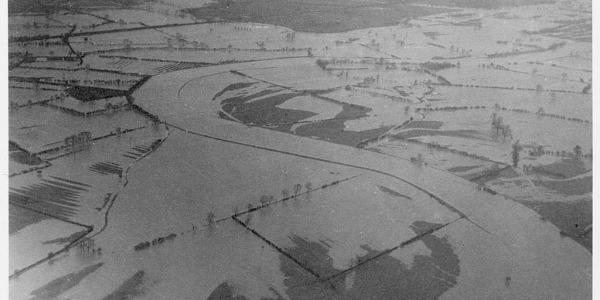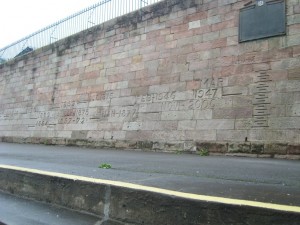
February 3, 2014, by Lucy
Getting into the archive – H.R. Potter
Although we’re still in the early stages of the project and very much finding our way through numerous ideas, technologies, and archive catalogues… I have managed to complete a few days of work in the archives. Deciding to start local, these days have been spent over at the Kings Meadow Campus of the University of Nottingham, home to Manuscripts and Special Collections. Archivist Sarah Colbourne invited Georgina and I over to talk about the water collections held by the University and to see if we thought there was anything we could use for the project – there certainly was!
Water Records at Manuscripts and Special Collections
I’d already had a search of the online catalogue and found a variety of weather related items that I knew I wanted to look at but Sarah’s introduction revealed just how extensive the water collection is (over 500 boxes of material). The materials she has picked out mainly belong to the H.R. Potter collection and so I thought I’d use this blog to tell you a bit more about it.
Harold Reeve Potter was a hydrologist who worked as Assistant Engineer for the Hydrology Department/Section of the River Trent Catchment Board/Trent River Board from 1950 to 1955, Senior Hydrology Assistant from 1955 to 1965, and subsequently as Hydrologist for the Water Resources Section of the Trent River Authority from 1965 to 1975. He deposited his papers with the University in two accessions in the 1990s so that they could be kept alongside the closely related files of the Hydrology/Water Resources Section of the Trent River Authority. He had a passion for the history of rivers and was skilled in using historical sources to gather data (both instrumental and descriptive) on extreme weather events. He then used these historical studies to inform the future management of rivers and water resources and to educate the wider public too through radio broadcasts and other public engagement initiatives. His work pioneered the use of historical sources within flood risk analysis.
The collection includes folders of materials Potter collected, organised by extreme weather event. Although the information is mainly focused on flood and drought events there are also mentions of severe downpours, thunderstorms and other weather events! The materials include copies of reports he wrote for the Trent River Board, correspondence with local authorities, maps and tables of flood level data, meteorological and agricultural reports, newspaper cuttings, photographs, and other ephemera. Just from a quick look at these sources it is possible to begin to establish a rough chronology of floods and droughts in the Trent river basin:
Floods
- 1795
- 1852
- October 1875
- December 1910
- May 1932
- January 1936
- February 1946
- March 1947
- March 1955
- September 1957
- July 1958
- Jan-Feb 1960
- December 1960
- December 1965
Droughts
- 1947
- 1955
- 1958-59
Today you can see many of the peak levels of the floods named above marked underneath Trent Bridge.
The Great Flood of 1875
Potter’s materials will help us to build up a picture of these past events and also to explore their presence and absence within both institutional and community memory. I wanted to end this post with an extract from ‘The Great Flood’ which appeared in the Nottingham Journal of October 29th 1875 (and which Potter included in his file of the 1875 flood event – HRP/F/1/3/1):
“… It now turns out that we have never had a spread of water in our midst equal to that in 1795 until Friday at about noon, for previous to that time the water had been no higher than the great flood in 1852… All night long on Thursday the water continued to rise… and on Friday morning… The scene was of a true Venetian character, people were cutting too and fro, some wading more than knee deep through streets, others paddling on half-immersed planks, while scores could be seen, even from such a high place as the Castle, fetching goods out of their homes, packing them on rafts, and then with all the awkwardness of dry land sailors managed to float their barks to more lucky neighbours who had been able to smile at the ravages of the elements, and yet keep them at bay… Here all neighbours who had little bones to pick with one another appeared from the bird’s eye view to have put all bickering aside, and were joining heart and hand in helping brethren in distress to make the best of a bad job…
More information
Sarah has so far been unable to find any photographs of H.R. Potter so if you know of any please do get in touch! We’d also love to find the recordings of the radio broadcasts mentioned…
- You can read more about H.R. Potter here: http://www.nottingham.ac.uk/manuscriptsandspecialcollections/collectionsindepth/water/hrpotter.aspx
- And you can see how Potter’s work is continuing to be used today in this paper by Neil: Macdonald, N. (2013) Reassessing flood frequency for the River Trent through the inclusion of historical flood information since AD 1320 Hydrological Research 44(2): 215-233.


Fascinating detail and so interesting to see reference to the 1795 and 1852 events too. This kind of ‘benchmarking’ is really useful in terms of tracing those kind of events that become inscribed into cultural memory.
This looks like a really interesting and well-timed project, and it’s great to see the region’s archival heritage being exploited in this way! I look forward to reading Neil Macdonald’s paper and finding out more about how Potter’s work was continued.